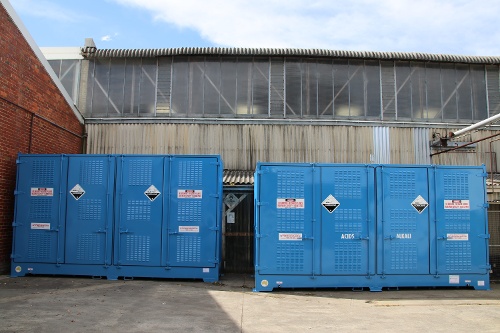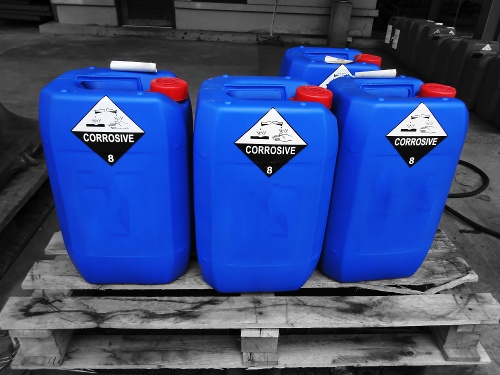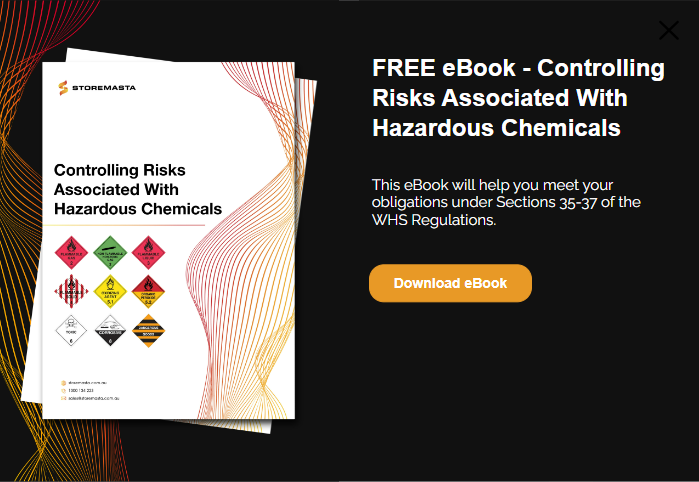Corrosive substances are unlike any other class of dangerous goods due to their ability to damage and corrode living tissue, wood, metal and other materials. Class 8 Corrosive Substances are defined by the Australian Dangerous Goods (ADG) Code as substances which, by chemical action, can cause severe damage to tissue, other goods and even the vehicles that transport the chemicals. When organisations are carrying this class of chemical, the key question is, how can you safely store substances which can potentially harm your staff, property, fleet and even the surrounding environment? In this blog, we’ll be taking a look at the outdoor storage requirements for corrosive chemicals — and highlighting some simple things you can do to reduce the likelihood of a corrosive chemical leak or spill in your workplace.
What Are Corrosive Chemicals?
Corrosive chemicals are used across a vast range of workplaces and can be found in cleaning products, drain cleaners, pool chemicals and fertilisers.
Acids and bases are the two main types of corrosive substances. Corrosive acids, including nitric acid, hydrochloric acid and citric acid, have a pH level under 7. Corrosive bases, on the other hand, have a pH level higher than 7 and include chemicals such as sodium carbonate, sodium hydroxide and aluminium hydroxide.
The pH level of a corrosive chemical is an indicator of how corrosive the chemical will be. While water has a neutral pH level of 7, corrosive substances will either have a pH level lower or higher than neutral. The further away from neutral the chemical is, the greater its corrosive capabilities are.
Highly corrosive acids, such as hydrochloric acid, have a pH level of 1.1. This means that this acid can irritate, burn and scar living tissue — even if just a few small drops make contact with the body or eyes. Sodium hydroxide, which is a corrosive base, has a pH level on the other end of the scale. At pH 13, this highly alkaline base must be handled extremely carefully, or it can cause intense irritation, burns and even fatalities.
IMPORTANT: While corrosive acids and corrosive bases are both recognised as Class 8 Corrosives, they are not compatible with each other. Always consult with your Safety Data Sheets for each individual product to determine the chemical segregation requirements for your acids and bases.
Corrosive Chemical Storage
To reduce the risks that corrosive chemicals pose, you should always store your Class 8 chemicals in a compliant store. AS 3780 – The storage and handling of corrosive substances is the Australian Standard which applies to your Class 8 substances. This Standard details guidelines for the safe storage of all Class 8 Corrosive Substances. The requirements include directions on store construction, spill containment, ventilation, emergency decontamination equipment, spill kits, chemical segregation, and separation from protected places.
We’ll take a closer look at each of these requirements in the next section of the blog.

AS 3780:2008 is the Standard which explains the requirements for safe storage of corrosive substances.
Corrosive Store Construction
If you’re storing corrosives in the outdoor environment, the Standard explains the types of stores that you can choose.
These include a:
- Designated open-air location
- Roofed structure or room which is attached to an external wall of another building.
- Freestanding, roofed structure or building that’s not attached to any other building.
Due to practicality and cost-effectiveness, many organisations select a chemical storage container or relocatable dangerous goods container to store their corrosive substances outside.
The requirements for an outdoor corrosive substance store includes:
- The store must be lined with corrosion-resistant materials
- Outdoor stores must be designed, constructed and operated in a way that allows for housekeeping to be carried out
- Any areas that are used for decanting must have floors that are sealed and drained to a suitable spill containment compound
- Storage areas must be secured against unathorised entry
- Stores must display the appropriate dangerous goods diamond and safety signage
IMPORTANT: When selecting a storage container for your corrosive substances, make sure it’s been designed and manufactured to meet all the requirements of AS 3780:2008.
Spill Containment
Whether you’re storing acids or bases, corrosive substances must be stored in a compliant chemical store with adequate spill containment. Due to the dangers associated with corrosive substance storage, especially in the outdoor environment, the Standard details the spill capacity requirements for all package stores.
Outdoor corrosive chemical storage containers must be equipped with a spill containment sump that can hold at least 25% of the storage capacity of the container, or the capacity of the largest container, whichever is greater. In all instances, the spill containment sump doesn’t need to be greater than 5000 L.
A corrosive substances outdoor store must be equipped with a liquid-tight spill containment system, with a compliant capacity that can adequately protect your business from the hazards associated with a chemical spill.
Ventilation
Section 4.4 General Requirements for Package Stores explains that package stores for corrosive substances must have adequate ventilation. The ventilation provisions should be determined by a risk assessment where the exposure levels of the corrosives store are measured and managed.
The workplace exposure standards, which details the requirements for airborne contaminants, lists a range of dangerous goods and their legal limits for hazardous vapours. While the outdoor environment is beneficial for the natural dispersion of vapours, you must ensure that your store is equipped with a compliant natural ventilation system, such as at least two walls of louvres.
Without adequate ventilation, workers could succumb to dangerous levels of hazardous vapours which may cause a range of health issues from nausea and dizziness to vomiting and asphyxiation.
Emergency Decontamination Equipment
If corrosive substances are splashed onto the skin or eyes — or they leak into the workplace or natural environment — there are a range of issues that will arise. Damage to property, vehicles, the contamination of the environment and human harm can occur if there is a chemical leak or spill involving your Class 8 substances.
Therefore, if your corrosives store is used for the opening of chemical packages, you must provide the appropriate emergency decontamination equipment.
The Standard explains that you should make provisions for:
- water for the washing of hands,
- eyewash facilities (complying with AS 4775),
- and a shower, plunge bath, or safety shower (complying with AS 4775)
We suggest conducting a risk assessment at your site to determine your specific emergency containment facility requirements. Keep in mind that your facilities must be located between 2 and 10 metres from your outdoor chemical store.
Spill Kits
In addition to your spill containment system and emergency decontamination facilities, installing a chemical spill kit is essential for managing any spills which may occur in the outdoor environment.
Due to the large quantities of chemicals that are often stored outdoors, it’s crucial that spills are cleaned up quickly and effectively to minimise damage to property, people and the environment.
Chemical spill kits should include a range of items which are compliant to WHS Regulations and Australian Standards. Always select a spill kit which suits your maximum chemical capacity and ensure that all appropriate PPE is used when a chemical spill clean up is in progress.

To avoid chemical spills, you must always practice safe handling and storage practices. Never leave containers lying around the workplace.
Chemical Segregation
When storing any type of hazardous chemical in the workplace, you must adhere to the dangerous goods segregation requirements of the particular chemical product that you’re storing. Class 8 Corrosive Substances are incompatible with many other classes of dangerous goods including:
- Flammable Gas – segregate from corrosive substances by a distance of at least 3 metres
- Non-Flammable, Non-Toxic Gas - segregate from corrosive substances by a distance of at least 3 metres
- Flammable Liquids - segregate from corrosive substances by a distance of at least 3 metres
- Flammable Solids – check the SDS of your chemicals to determine segregation requirements
- Spontaneously Combustible - segregate from corrosive substances by a distance of at least 3 metres
- Dangerous When Wet – check the SDS of your chemicals to determine segregation requirements
- Oxidising Agents - segregate from corrosive substances by a distance of at least 3 metres
- Organic Peroxides - segregate from corrosive substances by a distance of at least 3 metres
- Toxic Substances – check the SDS of your chemicals to determine segregation requirements
- Other Class 8 Corrosive Substances – some corrosive substances may react with each other, so check the SDS of your chemicals to determine segregation requirements
However, if you are storing corrosive substances in a compliant dangerous goods container or an outdoor chemical storage container, your storage facility will already off the necessary segregation for your corrosive chemicals. Therefore, you can house separate stores closer together if each class of dangerous goods is stored in a compliant chemical container.
Separation From Protected Places
To protect people from the hazards associated with corrosive substances, the Standard details the separation requirements for corrosive stores. If packages of Class 8 substances are opened in the store, you must separate your outdoor store from protected places by a distance of:
- 10 metres (for PG I)
- 5 metres (for PG II)
- or 3 metres (PG III)
If your store only houses packages that remain closed, it must be separated from protected places by a distance of:
- 5 metres (PG I)
- or 3 metres (PG II or PG III)
Storing Corrosive Chemicals Outdoors
Due to the hazards associated with Class 8 Corrosive Substances, choosing a compliant storage method is essential if you want to protect your business from spills, hazardous vapour emissions and chemical burns. Always consider the location, usage and ongoing maintenance of your corrosives store so you can remain compliant with WHS Regulations.
If you’d like to find out more about controlling the risks associated with corrosive substances and other dangerous goods, why not download our easy-to-read guide? Our eBook will introduce you to our 4-step risk management methodology and offer helpful tips on how to reduce chemical hazards in your own workplace. Grab your copy for free today by clicking on the image below.
Talarah has been working for Storemasta for many years, specialising in Marketing, Customer Service and Risk Management Solutions.
